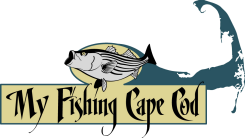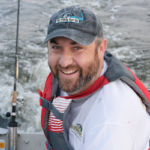Tactics and Locations for Cape Cod Anglers
The black sea bass season officially opened on May 17th, and despite some early challenges from a Memorial Day weekend nor'easter, Cape Cod anglers are starting to dial in on productive patterns and locations. Eddie Kooyomjian of Monomoy Tackle shares his early season thoughts on which approaches are working best to target keeper-sized fish.
Water Temperature Impact
Water temperature continues to play a crucial role in sea bass activity levels. During a recent family fishing trip to Monomoy over Memorial Day weekend, Eddy found that while the rips showed promising signs with abundant baitfish and active marine life, the cooler water temperatures suggested the prime bite might still be a week to ten days away. However, conditions are improving rapidly as we move deeper into May.
The presence of squid around Monomoy, along with mackerel chasing hooked squid behind jigs, indicates a healthy forage base that will attract and hold a variety of species in the coming weeks. These early signs suggest that prime time is just around the corner.
Prime Locations: South Side Takes Center Stage
While Buzzards Bay has historically been the epicenter of Cape Cod's black sea bass fishery, recent years have seen a notable shift in production along the south side. Areas off Hyannis and throughout Vineyard Sound have emerged as premier destinations for targeting keeper-sized sea bass, scup, and tautog.
Key Productive Areas Include:
Artificial Reefs: The two artificial reefs - one off South Yarmouth and another off Yarmouth - have been producing consistent action. These man-made structures concentrate baitfish and provide the rocky habitat that sea bass prefer.
South Side Off Falmouth: Recent reports from customers and the Fishing for the Mission 22 team indicate excellent sea bass action in waters south of Falmouth, extending toward Martha's Vineyard.
Hedge Fence to Hyannis Corridor: This stretch of water offers numerous humps, bumps, and structural changes that hold bait and attract sea bass. Anglers should focus on areas where depth finders show bottom irregularities and bait marks.
Noman's and Gay Head: For those willing to make the longer run on calm days, the deeper drop-offs around these areas can produce excellent fishing for larger sea bass.
Traditional Spots Still Producing
Cleveland Ledge - Buzzards Bay: Still produces fish, though keepers require more searching than prior years.
Tackle Selection and Rigging Strategies
Jigging Techniques: The Preferred Approach
Eddy's preferred method for targeting sea bass involves jigging, specifically using jigs paired with assist hooks. This setup provides several advantages:
Direct Connection: Assist hooks create a solid connection between the angler and fish, transmitting every head shake and pull directly through the line. This enhanced sensitivity makes the fishing experience more engaging and helps detect subtle strikes.
Jig Varieties:
- Slim profile resin-coated jigs for active presentations
- Slow-fall jigs designed for slow-pitch techniques where fish often strike on the drop
- Color variety is crucial, as sea bass can be surprisingly selective
Slow-Pitch Jigging Technique
This increasingly popular method involves dropping the jig and allowing it to flutter back toward the bottom. Fish often strike during this falling phase, and anglers will either feel the strike or notice the jig suddenly stop falling - indicating a fish has taken the lure. This technique adds an element of excitement as strikes can occur at any moment during the retrieve.
Traditional Bottom Rigs
High-low rigs and single-hook setups remain effective, particularly when paired with natural baits or used as teasers. These traditional approaches work especially well on days when fish are less aggressive or when fishing with younger anglers.
Bait Selection: Natural Options That Produce
Green Crab: The Selective Choice
Green crab emerges as a standout bait for several reasons:
Species Selectivity: Unlike squid, which attracts a wide variety of species, green crab tends to filter out smaller fish while appealing to target species like sea bass and tautog.
Substantial Profile: The larger profile of green crab requires fish to commit more fully to the bite, often resulting in better hook-ups with keeper-sized fish.
Versatility: Green crab works effectively in the same rocky, structured areas where both sea bass and tautog are found, making it ideal for mixed-bag fishing.
Squid: The Universal Attractor
Fresh local squid remains a premier bait choice, though it does attract a broader range of species:
Broad Appeal: Squid attracts virtually every predator species in Cape Cod waters, making it excellent for exploratory fishing or when trying to locate fish.
Easy Availability: Squid can often be caught fresh on-site by jigging, providing the freshest possible bait.
Versatility: Works equally well on jigs, high-low rigs, or as teaser baits.
Color Considerations and Fine-Tuning
Sea bass demonstrate surprising selectivity when it comes to lure and rig colors. Successful anglers maintain a variety in their tackle boxes:
Pink: Often effective during certain conditions and times of day.
Chartreuse: A reliable producer that imitates various natural forage items.
Crab Imitations: Dark green and orange colors that mimic the natural coloration of green crabs can be particularly effective when fish are feeding heavily on crustaceans.
The key is being prepared to switch colors based on fish preferences, which can change not only day to day but even hour to hour.
Species Diversity: Bonus Catches to Expect
Scup: An Underrated Fighter
Large scup, particularly those in the 15-inch range, provide exceptional sport when caught on jigs or assist hooks. These fish pull surprisingly hard and offer entertainment value that rivals their more famous cousins. Recent reports of large scup taking tog jigs in Buzzards Bay demonstrate their aggressive nature and willingness to take substantial baits.
Tautog: Incidental but Welcome
The overlap between sea bass and tautog habitat means anglers often encounter both species when fishing rocky structure with green crab baits. This species diversity adds value to fishing trips and provides options when one species proves challenging.
Strategic Recommendations for Success
Mobility is Key: Don't commit to a single location. Cover water and explore different depth ranges and bottom types until you locate active fish.
Technology Utilization: Use depth finders to locate bottom irregularities, humps, and bait concentrations. Sea bass relate strongly to structure and bait presence.
Tackle Variety: Maintain options in both jigs and baited rigs. Fish preferences can change throughout the day, and having multiple approaches increases odds.
Bait Quality: Prioritize fresh, local baits when possible. Green crab and fresh squid consistently outperform frozen alternatives.
Weather Windows: Take advantage of calm conditions to explore more distant locations like Noman's and Gay Head, where less fishing pressure often means better opportunities.
The 2025 black sea bass season is shaping up to offer excellent opportunities for those willing to adapt their tactics and explore beyond traditional locations. Eddy urges folks to take advantage of improving weather windows to get out and explore Cape Cod's robust bottom fishery and to step outside traditional comfort zones when targeting sea bass.
Tight lines, take care, and thank you for listening!

